Your friendly neighborhood architect is back with another edition of Roster Rebuild, and with good reason – the Pittsburgh Penguins are over the cap! To be precise, according to CapFriendly, Pittsburgh is currently $2,316,842 over the salary cap and still has to sign Drew O’Connor. That projected signing will take the Penguins to over $3 million above the cap. Yes, any team can go over by 10 percent during the offseason, but the summers fly by fast, and before you know it, you’re in a junior arena watching a rookie camp tournament getting far too excited by certain players out there (you should have seen Morgan Rielly, coming off of a torn ACL, and J-G Pageau tearing it up for Toronto and Ottawa respectively back in 2013. Beasts, they were).
With this in mind, we will first look at the players the Penguins should focus on signing, trading for, and trading away. Then, we will examine what the finalized summer roster would look like.
Related: Pittsburgh Penguins Really Don’t Need Erik Karlsson
Fans and media alike are constantly focusing on certain, but not all, areas of roster building. Building a team goes beyond “who’s a good player?” “who fits in our system?” and “does his cap hit fit within our cap?” or at least, it should. As a team builder, I’m looking at multiple key factors, and this is where psychology comes in. Who is in the last year of their contract? Who is fighting to keep their career? I want those players. They will be amped up to have a great year, and more often than not, players show up in their walk year (the last year of a contract before becoming an unrestricted free agent). If they don’t, they’re generally harmless to remove, as long as the contract they receive doesn’t look like the Ryan Reaves signing.
As an older team whose window is clearly closing, it would behoove the Penguins to acquire as many ultra-motivated players as possible. If you know anything about Sidney Crosby, you know that his daily, weekly, monthly, and yearly motivation is greater than just about anyone else’s on any given day. You need as many highly motivated players as possible simply to keep up. If the team is close to as motivated as Sid is, then it’s a team that has a shot at winning it all.
Unrestricted Free Agents to Choose From
Pius Suter
When you’re talking about him in the boardroom while looking at your depth chart and how much Pius Suter made in 2022-23 ($3.25 million), you’re asking yourself, “How much cap space can I clear, and what will he sign for?” The longer he’s on the market, the more leverage you’re likely to have as the player will get antsy.
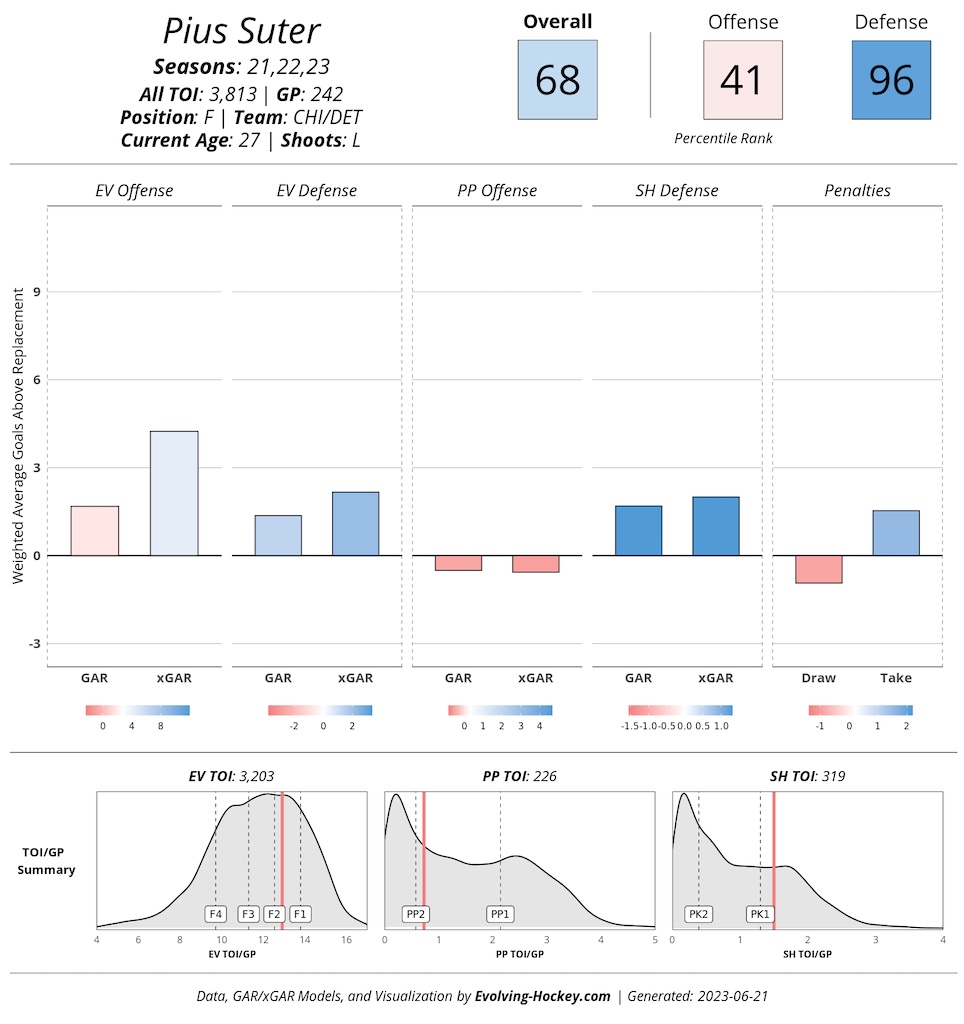
With that being the case, if you wait too long, inaction will cost you the player to another team who took action. I think you could get him for $2.25 million. However, with the space and to ensure a yes from him and his agent, a one-year, $2.5 million offer does the trick. This is a win-win deal as it gives Suter real money and a chance to anchor a third line on what should be a playoff team and a better team than he played on with the Detroit Red Wings the past two seasons. He’ll be motivated to cash in next summer when the salary cap is projected to rise, and a motivated player will play hard for your team in the upcoming season.
Ethan Bear
A player I’ve liked since his rookie season with the Edmonton Oilers, Ethan Bear would be a strong replacement for Jan Rutta and would add to the overall defensive depth. Rutta played a fairly quiet style alongside Victor Hedman in Tampa Bay, and when he brought that quiet game to a team that needed something more, the silence was deafening.
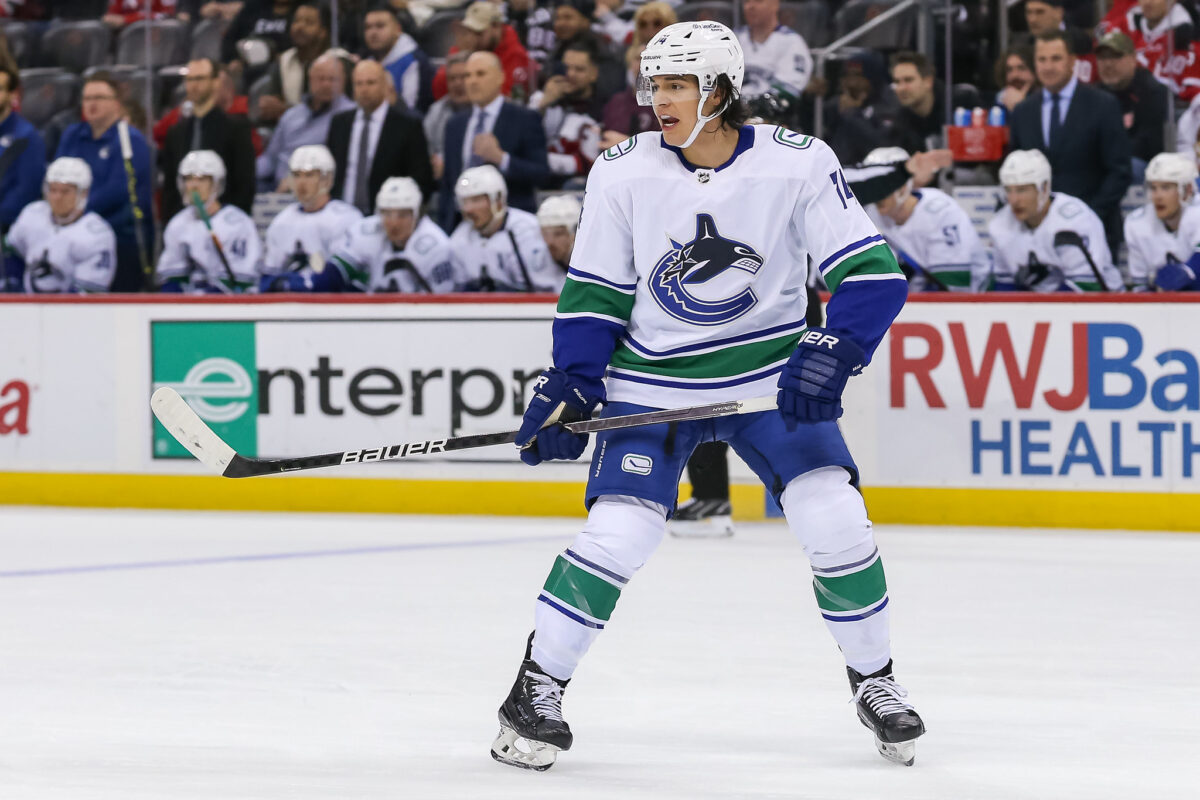
On the other hand, Bear has a history of positive defensive impact, is still young at 26 years of age, and should be healed up from the shoulder injury he suffered at this year’s World Hockey Championships in time for the stretch run and playoffs. Adding both him and our one trade target also provides options should there somehow, some way, be a miracle that removes Jeff Petry’s contract from the team.
Carl Hagelin
What a mess this guy’s body is. It goes to show what players go through to even have a chance to win the Stanley Cup. Carl Hagelin has been quite complimentary of his treatment from the Washington Capitals; really, he seems far too comfortable there for a player who was part of a team that haunted the Capitals for years. In all seriousness, if he’s willing to come back to the scene of his greatest victories and recovers from the hip surgery well enough to still have his speed, then Hagelin could still be an effective bottom-six player, very likely on the fourth line. Between him and Andreas Johnsson, Pittsburgh will need one of them to hit.
Player to Trade For
Dylan DeMelo, Right Defenseman
A defensive defenseman who you can pair with an ace offensive defenseman or use in a shutdown pairing. This is DeMelo’s walk year, and Winnipeg as a city or the Jets as a franchise are not exactly a destination city or team, so he’s another player who will be motivated to produce and be a key part of a winning team.

Penguins Players to Trade
Jeff Carter & Mikael Granlund
Both forwards are overpaid, and both seem to have lost a step. Carter and Jeff Petry (whom I actually like as a player) both have full no-move clauses, so they have total control over whether they stay in Pittsburgh or are traded and to which team they’re traded. As I feel that Carter’s smaller contract, name value, and Stanley Cup experience will be beneficial to another club, he should be the easier player between him and Petry to trade, so we’ve done that here.

Detroit is one of the few teams that has the cap space to accommodate bringing in Carter. Again, geography is often an issue here. Carter is from London, ON, which is an easy drive to Detroit for his family if they are still in that area. While Carter’s contract should only cost a third-round pick, Red Wings icon and general manager Steve Yzerman has never been in the business of doing teams favors with his trades. A shrewd GM would absolutely have a Carter Trade Tax here, and Yzerman is most definitely shrewd.
Granlund was an abject disaster last year, both on a fledgling Nashville Predators team and a far more offensively dynamic (on paper), hit-and-miss Penguins team after the deadline. He’s either done, or he’ll blow the walls down this year. Someone will look at his analytics and say that he was far better on the Penguins, even though the eye test said otherwise, and his scoring a single goal and adding four assists for five points in 21 games says something far different. His low percentage of offensive zone starts is noticeable in that regard. Either way, we know from a past article that the established cost of trading a contract his size is a second-round draft pick.
Granlund & Rutta to the Coyotes
The Arizona Coyotes have four top-six forwards, so there’s the chance that Granlund, under zero pressure on a fun team, makes that comeback. He’s potentially still an upgrade over a couple of Arizona’s forwards. As it relates to the cost mentioned above, we include Rutta in the deal for a few reasons.

First, Rutta has no clauses protecting him from a trade. He is not the solution in Pittsburgh, though he will be an upgrade on an Arizona team that has decided to be competitive this season. Arizona has six defensemen signed to contracts, though only five played last year, as the ever-jinxed Travis Dermott (maybe one of the best defensemen in the league at shutting down the rush in the neutral zone) missed last season with a concussion. It was not his first, and as such, you cannot bank on a full season from Dermott.
Finally, Rutta, on an affordable contract and with a hand full of Stanley Cup rings, has value, especially to a young team who will love hearing about how his team won two Stanley Cups. He drops the cost of trading Granlund a full round, from a second to a third-round draft pick.
The Cap-Compliant Penguins Training Camp Roster
This roster, now nearly $2.5 million under the salary cap, has a lot of flexibility across the lineup, which is a blessing as long as you have a coach who can maintain control and discipline when making lineup changes, which Penguins coach Mike Sullivan can.
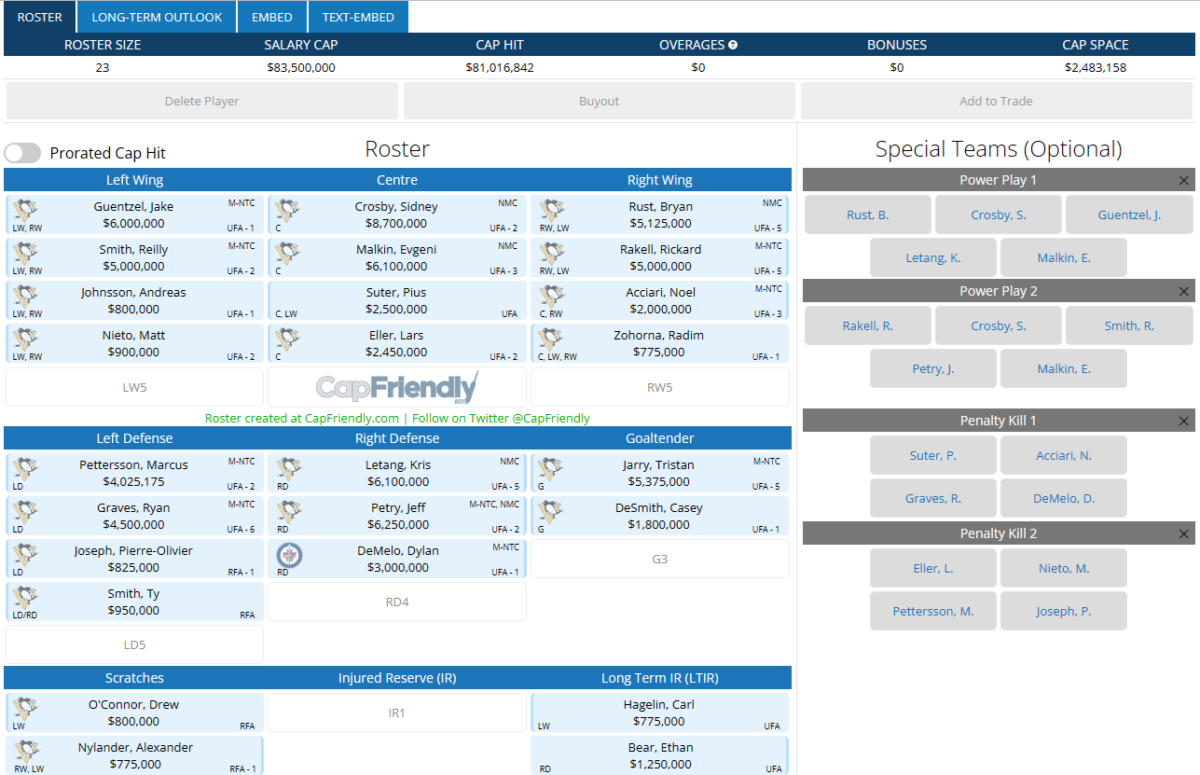
Bryan Rust is really a key for the first line in that if he finds his game (read: foot speed) this year, he’ll make Pittsburgh far more dangerous at the top. Add to that a typical season from Crosby, and Jake Guentzel would make this line one of the best first lines in the NHL.
The second line is stronger than last year, with Reilly Smith’s strong two-way play and steady offense a welcome addition to Geno and Rickard Rakell’s strong chemistry.
For my eyes, this bottom-six features four 4th liners, so they will need someone to stand up. Suter is a really solid 200-foot player who makes the team better and deeper down the middle. Noel Acciari is a favorite of mine — a speedy, smashmouth, forechecking beast who added a completely new element to Toronto’s lineup down the stretch and in the playoffs this past season. He was an unsung hero there and should do the same for Pittsburgh.
Andreas Johnsson was once a success story as a seventh-round draft pick (also of Toronto) who ascended through the ranks to be the top LW alongside Auston Matthews. His speed, forechecking, good vision, and solid hands made him the perfect top-nine player who you can plug into a scoring line and be a positive there.
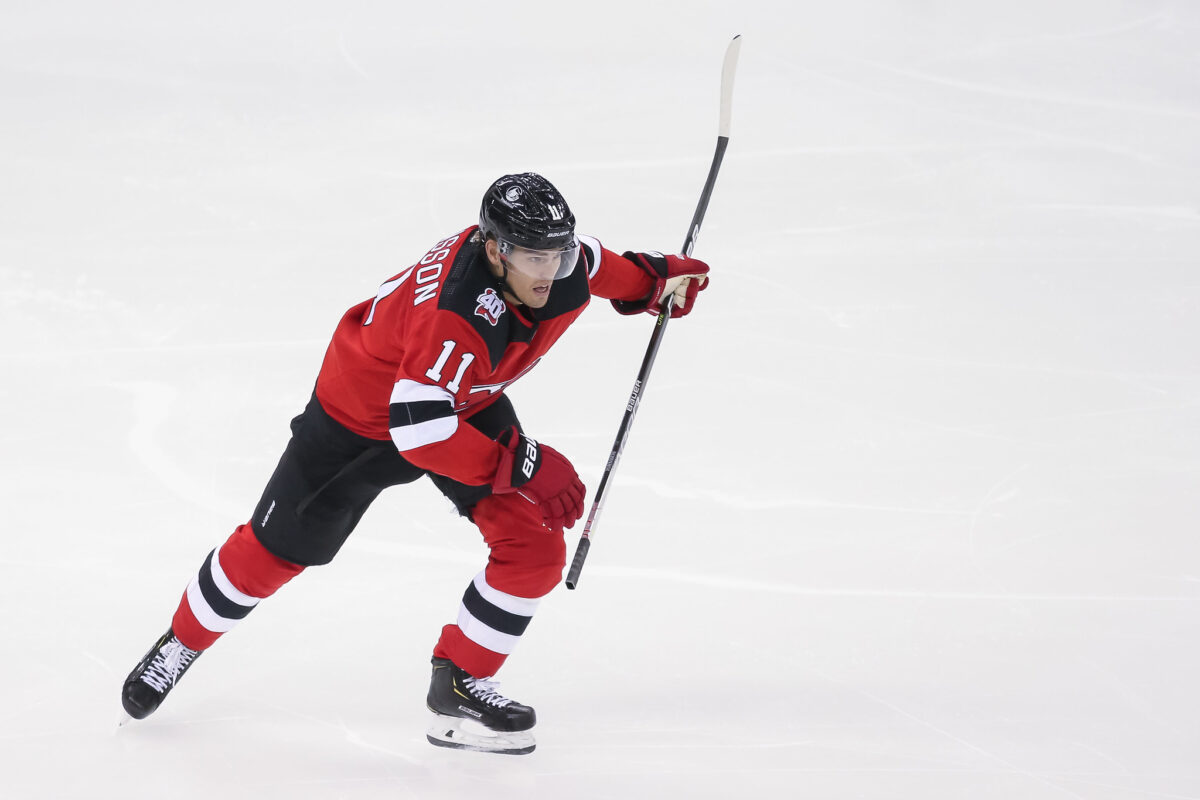
Johnsson may have peaked early, as he lost a step at a young age, which took away all the effectiveness from his game as he couldn’t be in position to do the things he used to do. On this team, he simply has to be strong on the forecheck, play a solid cycle game, and backcheck hard. If Johnsson can do that, he will continue to be an NHLer.
The fourth line is stronger for having Lars Eller on it. While I get that he is talked about as a third-line center, the reality is that at this point in his career, he’s likely a fourth-line center on a true Stanley Cup contender. The same for Matt Nieto, as both should have some motivation after being a part of Colorado’s dethroning in the spring. The wild card here is our fourth-line right wing, Radim Zohorna, who beats out the incumbent Drew O’Connor on my team.
Who’s Radim Zohorna, you ask? Let’s find out.
Zohorna is 6-foot-6, 220 pounds, and has 11 points in 35 NHL games to date. He can play all three forward positions, though as Nieto is primarily a left wing, Zohorna will line up on the right side. Zohorna had a great training camp with the Penguins last season, using his speed and physicality to make his presence known. He was thought by many to have a legitimate chance at making the team out of camp, adding the physical element it was well-known by most that Pittsburgh needed. Instead, he was cut near the end of training camp, which led to a whirlwind season for him.
Zohorna was waived during camp and claimed by the Calgary Flames. He played eight games with Calgary and another 40 with their AHL team. He was dealt at the trade deadline in March to Toronto, where he scored one goal in two games. His speed and forechecking were noticeable in a small sample size with Toronto, the same play that perhaps should have had him on Pittsburgh to begin with last fall.
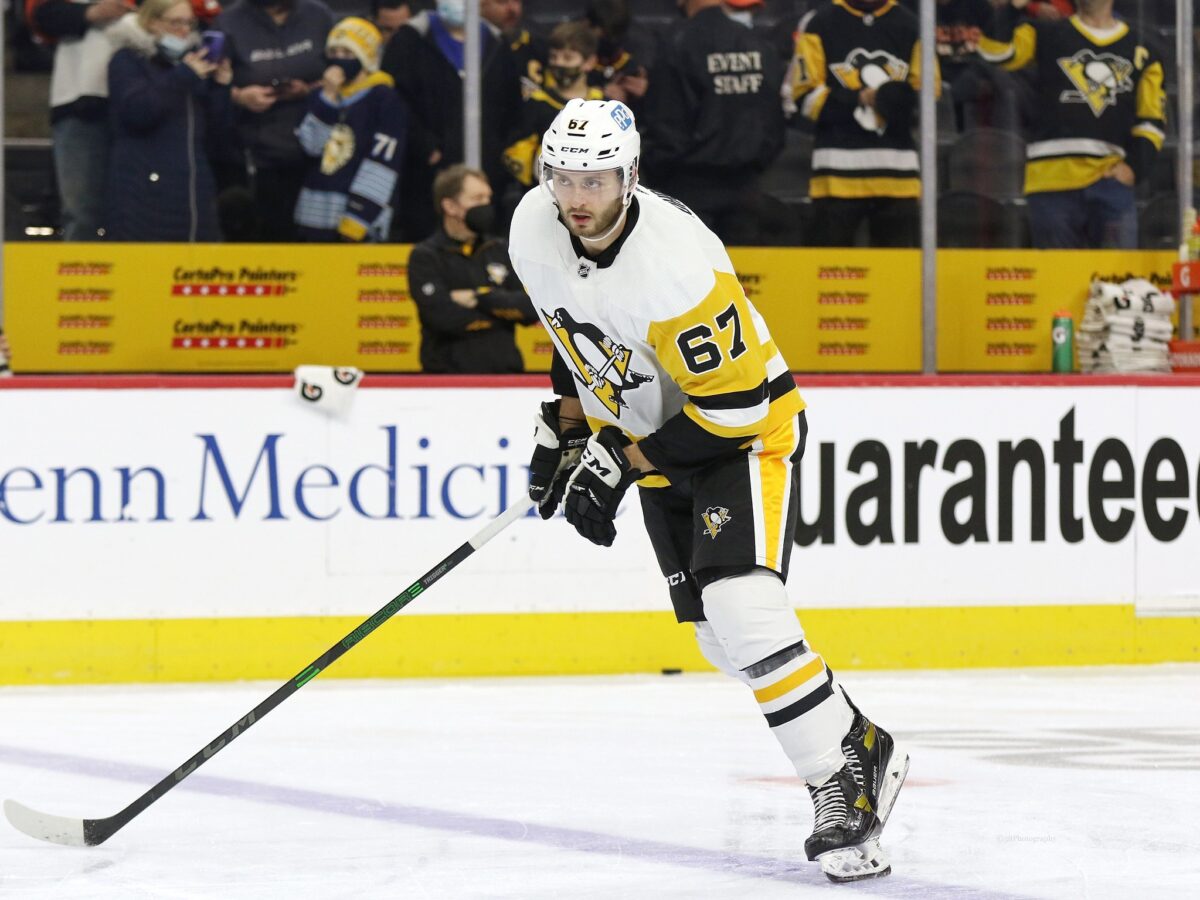
Now, back in Pittsburgh as an unrestricted free agent signed on July 2, there is clearly still a belief in his ability from both those in the front office who saw him last year and President of Hockey Ops Kyle Dubas, who saw him during the regular season with the Leafs. If he’s ever going to do it, now is the time for him to play in the NHL.
Acciari is a perfect role model style-wise, and they played together briefly in Toronto, so they at least know one another. Zohorna is a zero-risk, pure upside play for Pittsburgh, which could save them from having to spend an asset on acquiring another player. His minimum salary cap hit also gives the Penguins more room to maneuver throughout the season should he work out. This is the year that Zohorna gets the chance to play which he should have received last season.
While the potential that the Penguins trade for Erik Karlsson remains quite real, the high degree of difficulty in making such a trade means that Dubas and his team must have options. This is a solid team that, with a crew of motivated players and a much-improved defense, can indeed return to Stanley Cup contention.
